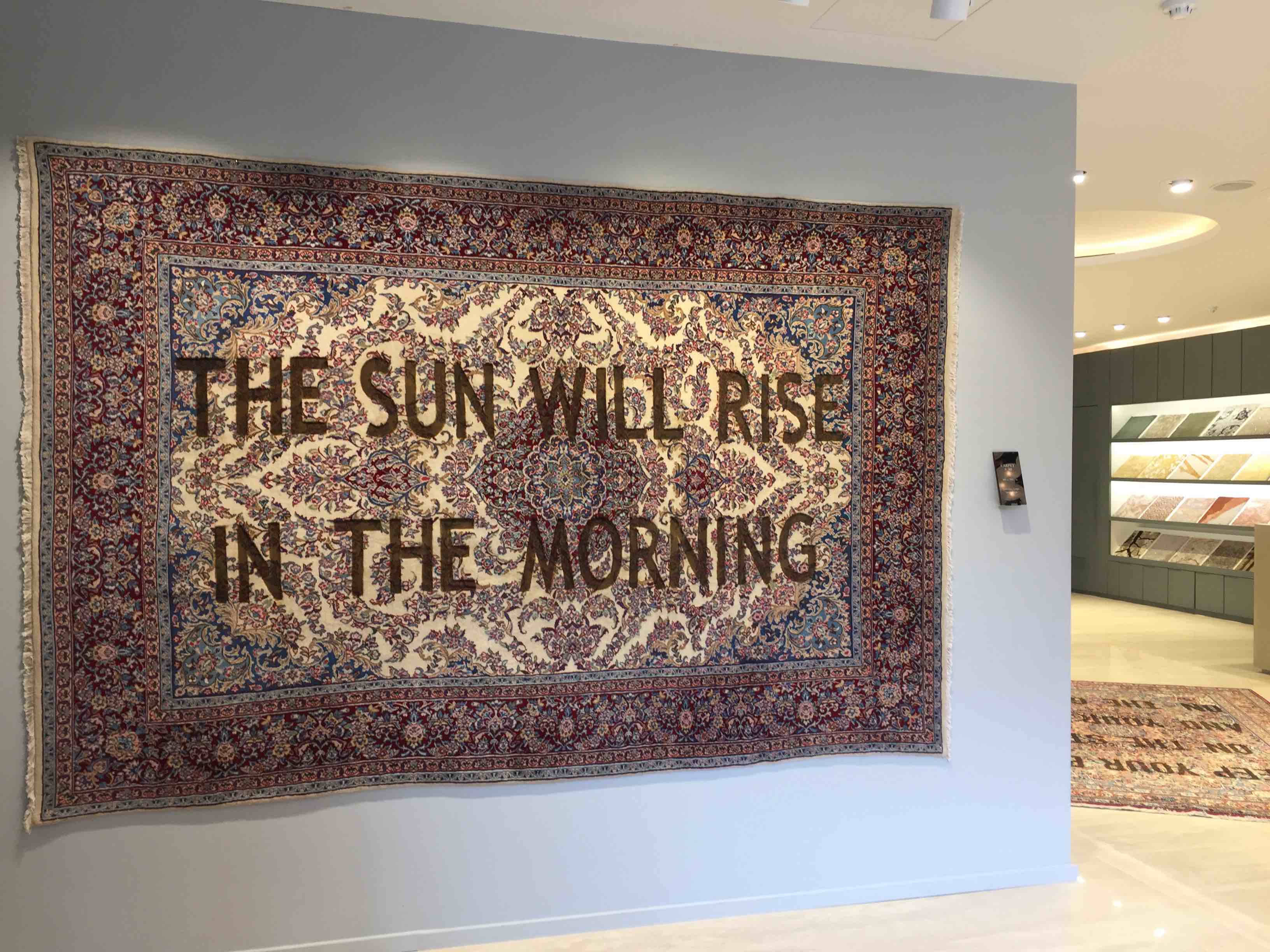

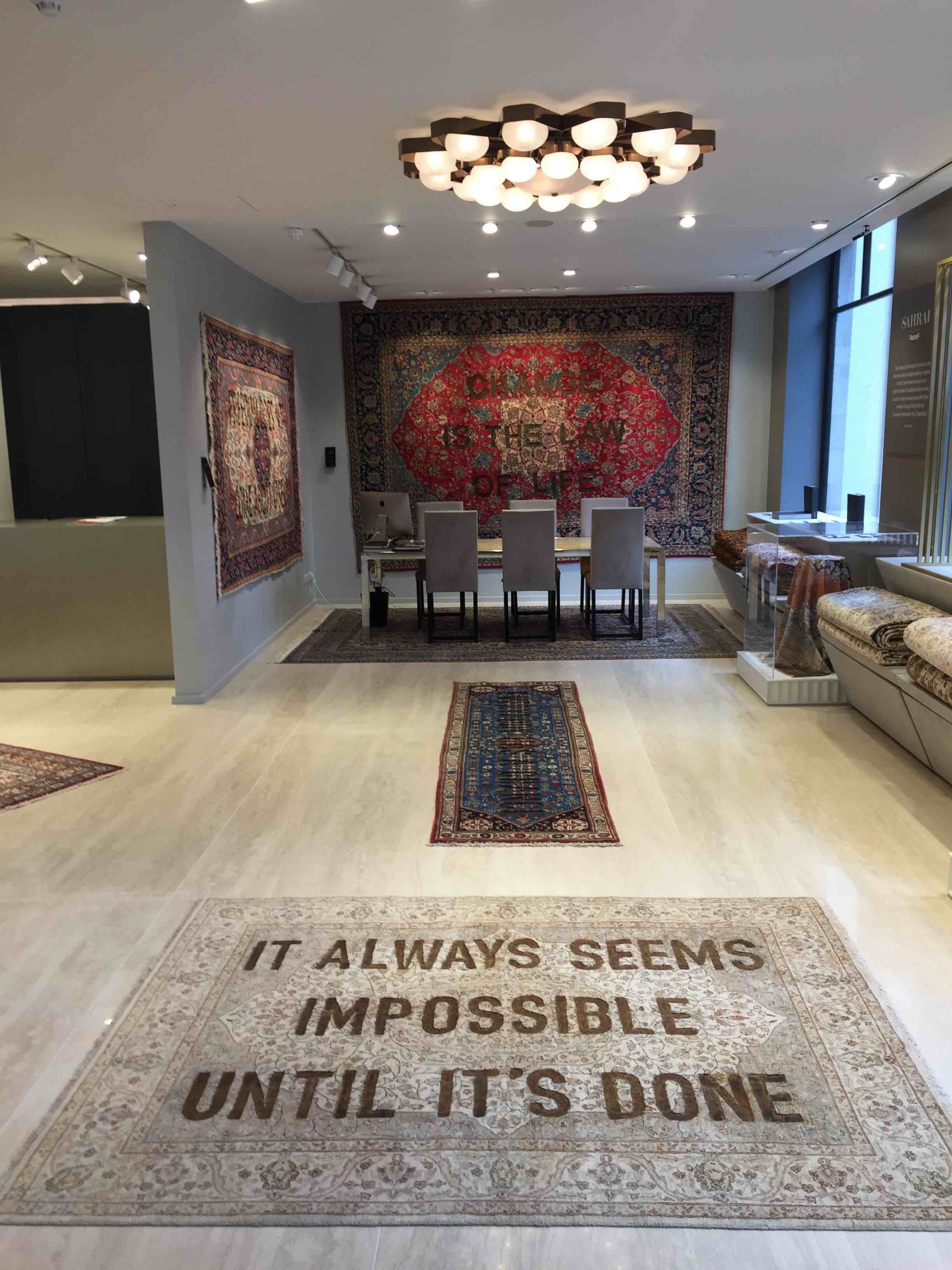
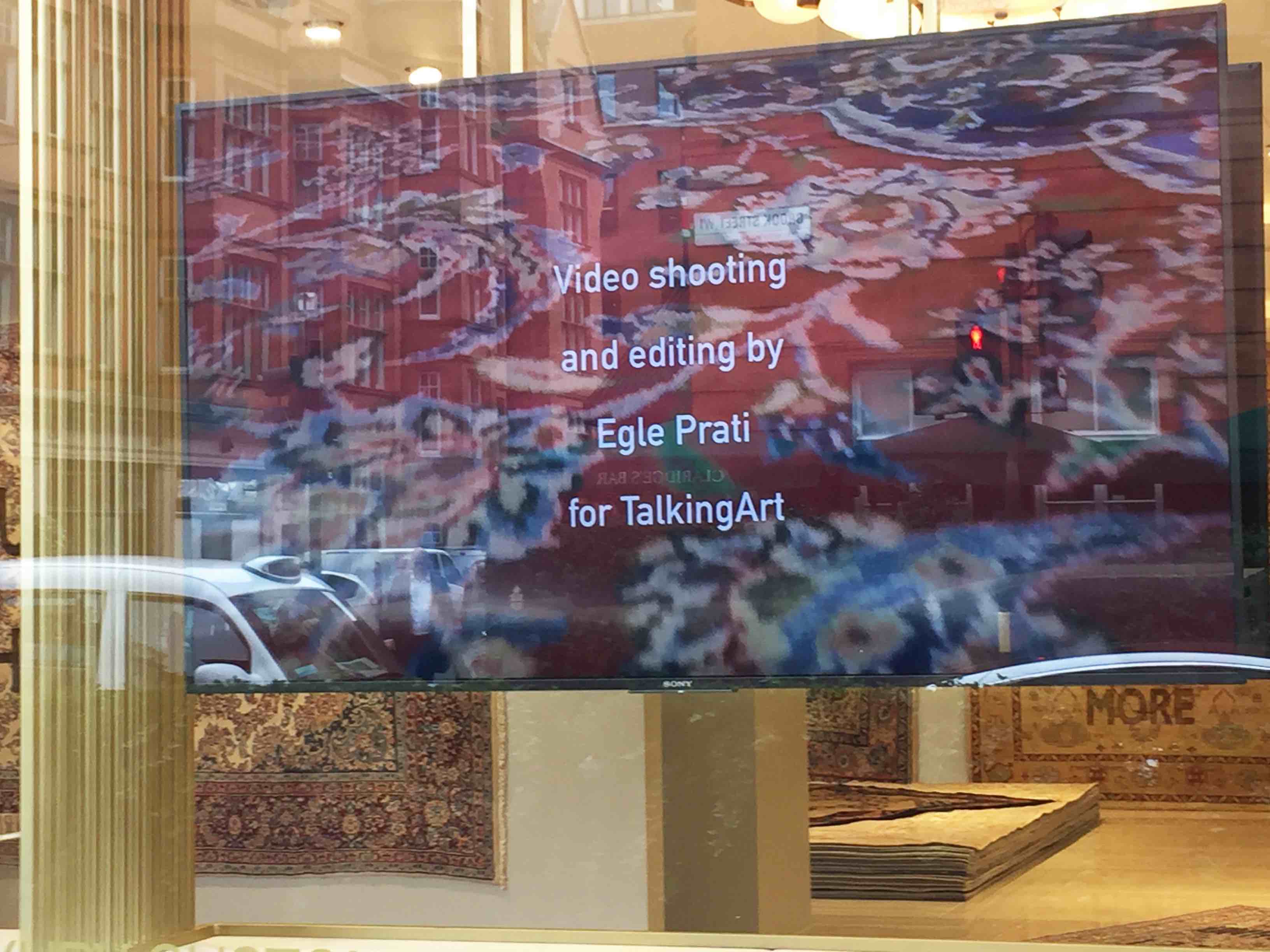
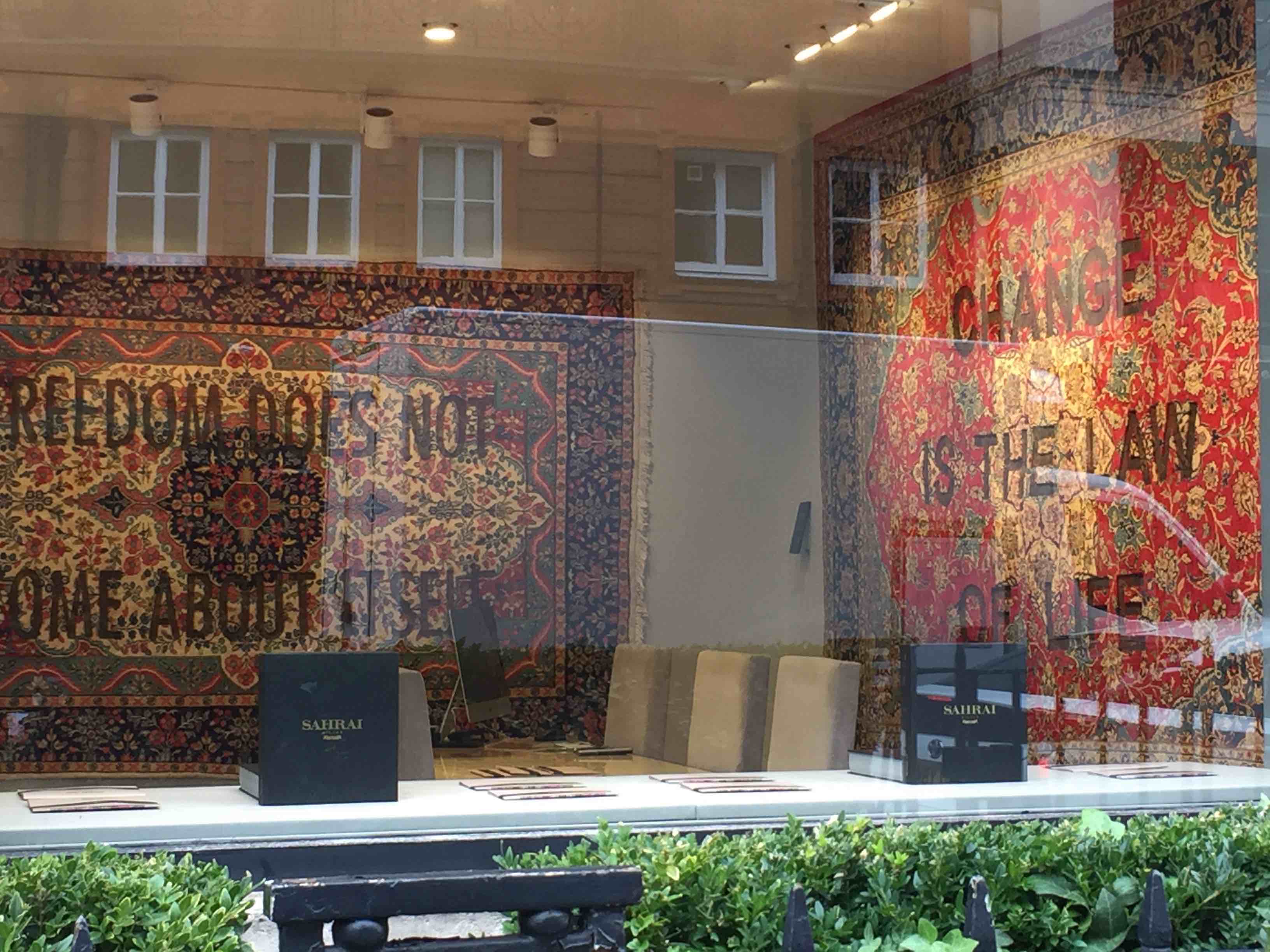
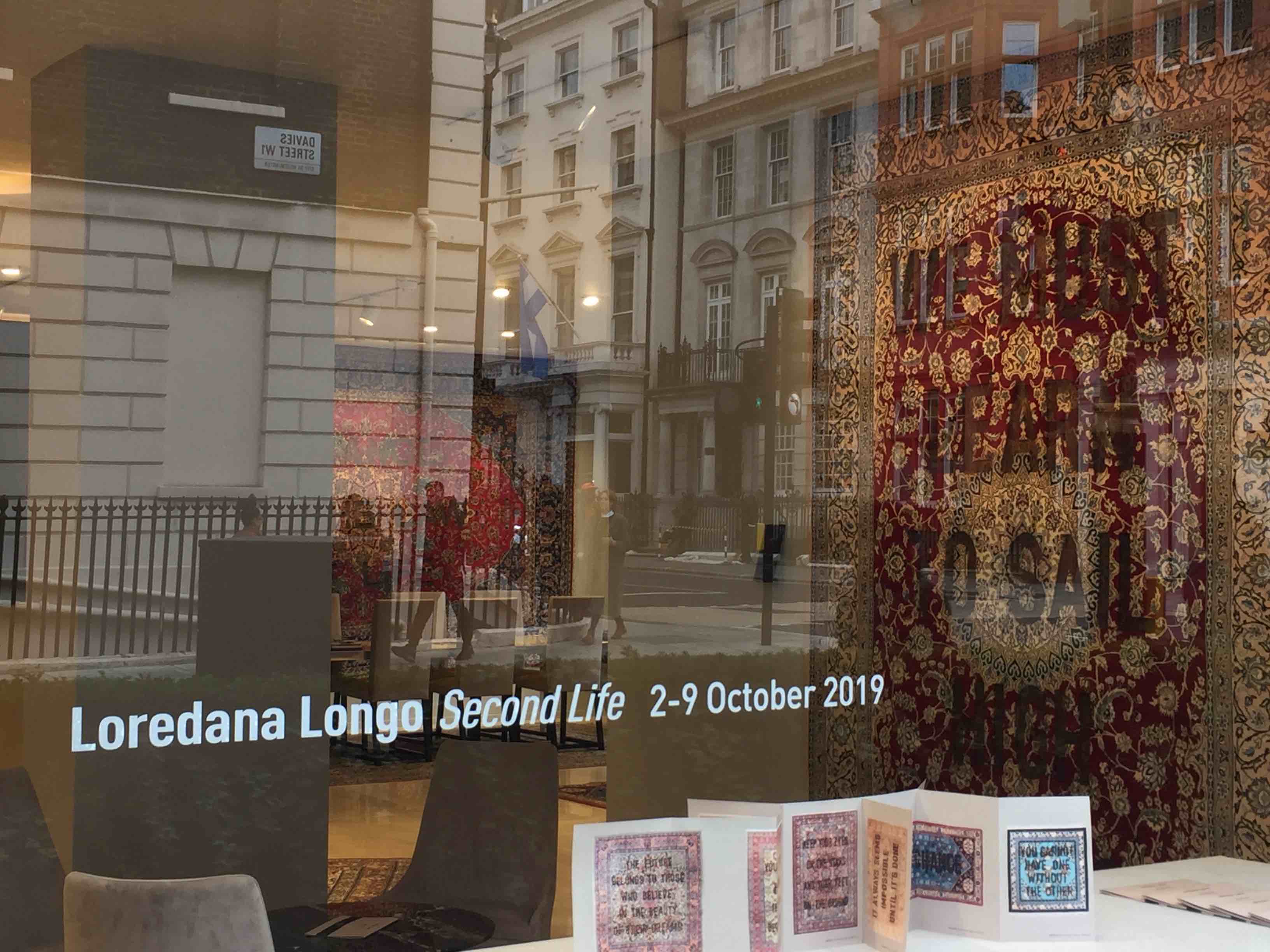
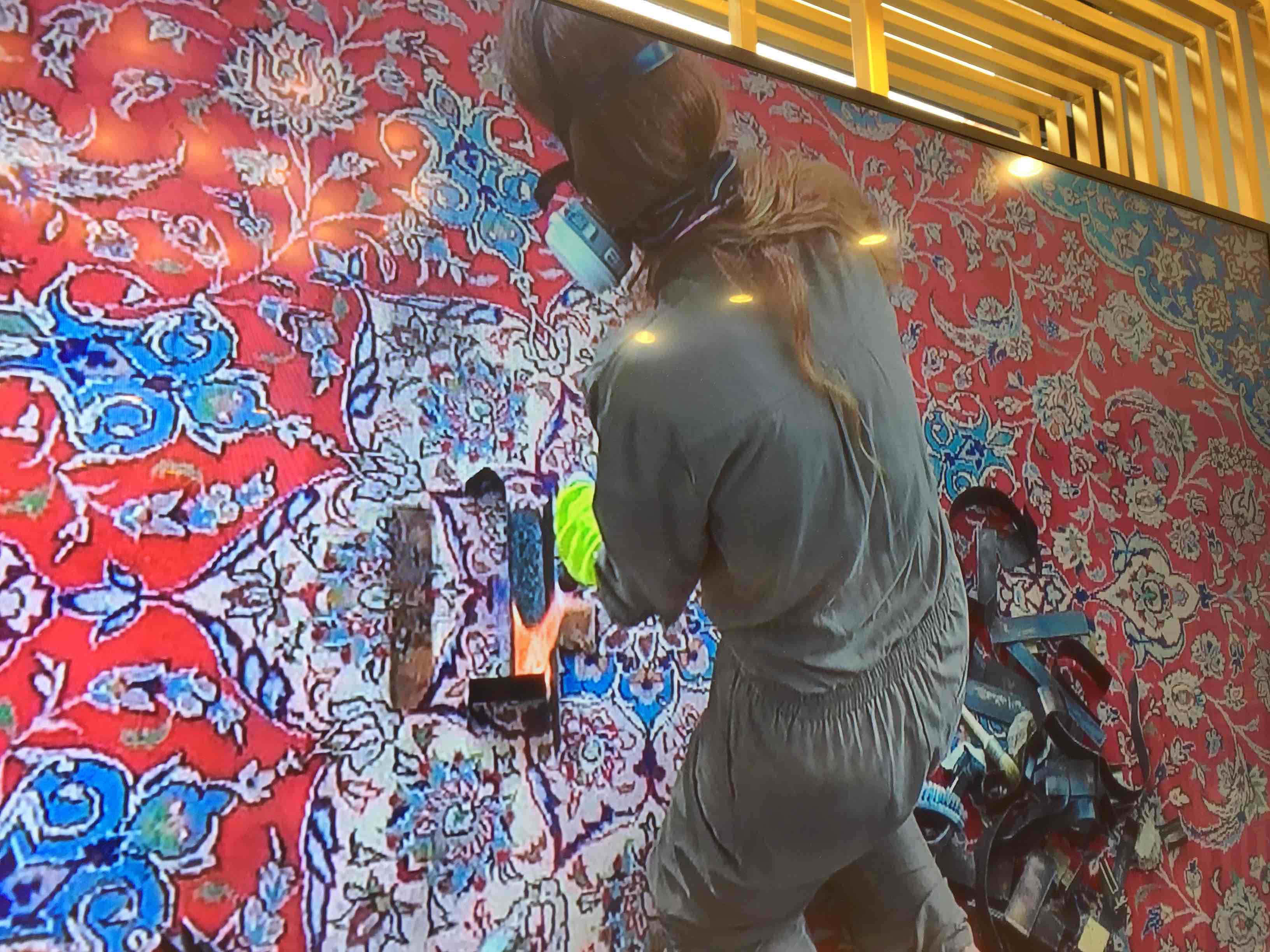



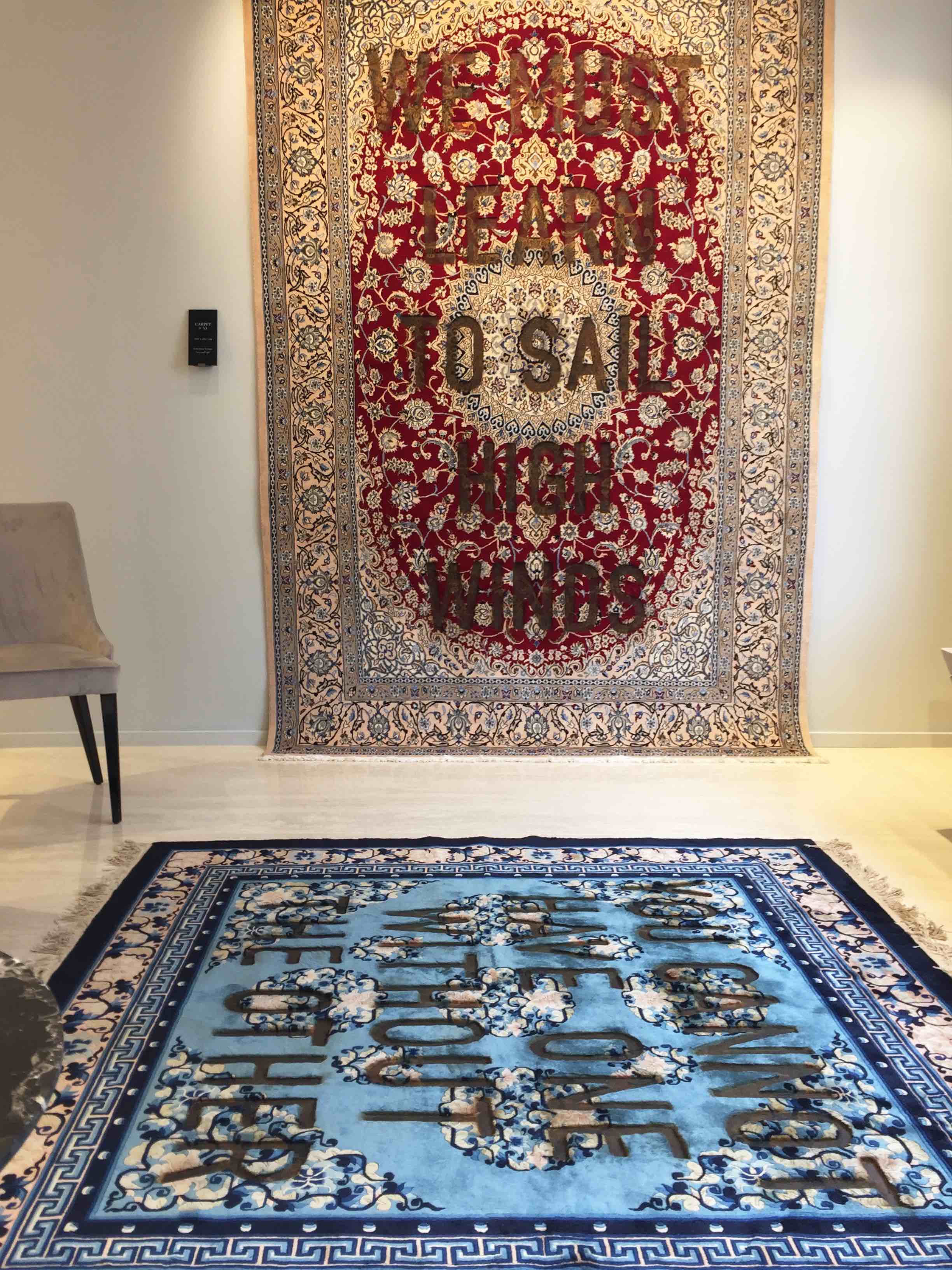
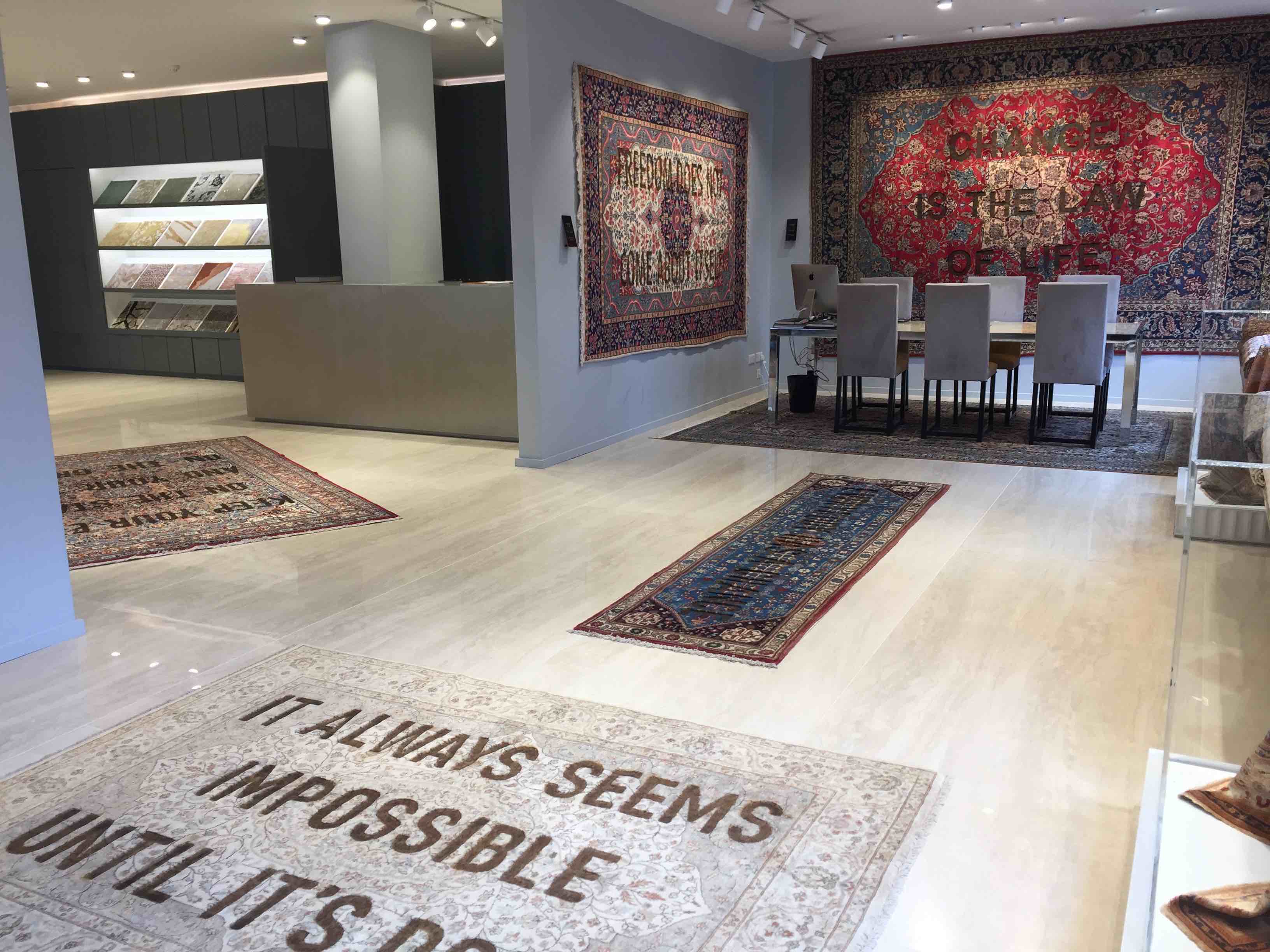
SECOND LIFE
2019, Sahrai flagship, London
a cura di Marina Dacci
bruciature su
tappeti orientali, 11 tappeti, dimensioni variabili
GUARDA IL BACKSTAGE DI SECOND LIFE SU TalkingArt
Elenco dei tappeti esposti:
Carpet # 25 - It always seems impossible until it's done
2019
burning on Rama carpet, 230x170 cm
Carpet # 26 - You cannot have one without the other
2019
burning on Pekino carpet, 273x184 cm
Carpet # 2- The future belongs to those who believe in the beauty of their dreams
2019
burning on Ziegler carpet, 295x250 cm
Carpet # 28- Everybody has a chance
2019
burning on Abadeh carpet, 295x80 cm
Carpet # 29 - We can always aspire to something more
2019
burning on Ziegler carpet, 295x231 cm
Carpet # 30 - The sun will rise in the morning
2019
burning on Ravar carpet, 300x200 cm
Carpet # 31 - You can't wear the crown if you can't bear the cross
2019
burning on Varamin carpet, 301xx238 cm
Carpet # 32 - Freedome does not come about itself
2019
burning on Kerman carpet, 302x202 cm
Carpet # 33 - WE must learn to sail high winds
2019
burning on Nain carpet, 309x202cm
Carpet # 34 - Keep your eyes on the stars and your feet on the ground
2019
burning on Moud carpet, 303x215 cm
Carpet # 35 - Change is the law of life
2019
burning on Esfahan carpet, 375x260 cm
GUARDA LA SERIE COMPLETA CARPETS
Testo di Marina Dacci
Nella ricerca di Loredana Longo, già dal 2000 si è affiancato l’uso esplicito del linguaggio scritto in dialogo con quello iconografico attraverso interventi gestuali e performativi. I primi lavori sui tappeti risalgono al 2013, specificamente legati alle problematiche del Mediterraneo.
Forse però il primo antecedente di questi lavori è rintracciabile nella serie del 2011-2012: Floor. Le ragioni e la nascita di queste opere si legavano alla cementificazione e alla speculazione selvaggia o alle private violenze domestiche, ma sui pavimenti in cemento affioravano abiti da lavoro o vestiti neri femminili che richiamavano corpi assenti.
Gli abiti richiamano corpi, ma anche il linguaggio, codice primario dell’uomo, richiama corpi di persone,
identità e relazioni. Le frasi selezionate dall’artista evocano persone specifiche, perlopiù politici occidentali, che hanno segnato la nostra cultura e si sono radicati nell’immaginario popolare.
A ben pensare le frasi sono iconografie: ritratti delle personalità che le hanno scritte o pronunciate, in modo così potente che possiamo visualizzare i loro corpi, i loro gesti.
Si tratta di dichiarazioni di sapore “libertario” trasferibili nelle praxi di vita quotidiana: speranza, futuro migliore, collaborazione, aspirazione verso la libertà, tolleranza e rispetto, che dalla sfera politica e sociale possono slittare,
in chiave proattiva, nell’ambito squisitamente personale.
Ma anche aforismi che, depauperati e banalizzati rispetto al contesto in cui sono stati pronunciati, hanno assunto anche il sapore di veri e propri slogan rientrando nell’ambito del marketing pubblicitario.
Questi motti, si innestano in un “territorio” preesistente: il tappeto orientale.
Il tappeto non è un territorio neutro, il tappeto non è la tela vergine del pittore. E’ un luogo “inquinato” dal suo vissuto come oggetto, come luogo/simbolo tout court che raccoglie i passi e le azioni dell’uomo sia nei luoghi dell’intimità domestica sia in quelli deputati alla condivisione sociale e spirituale.
Nella fase della sua produzione il tappeto accoglie l’energia e la perizia delle mani degli artigiani che l’hanno realizzato, perlopiù femminili, e presenta segni e decorazioni tratti da precisi valori culturali e visivi delle
comunità in cui è stato realizzato. Il tappeto è anche un elemento immaginifico nelle narrazioni orientali capace di trasferirci in altri luoghi, di darci nuovi occhi sul mondo.
...Ci viene insegnato che nella lingua araba classica una radice comune lega tappeto e farfalla e certo non soltanto per la fascinazione dei colori. Il tessere e l’annodare alludono di per sé alle vicende ordite per gli uomini da invisibili mani...il tappeto vola perché è terra spirituale, i disegni del tappeto annunciano quella terra, ritrovata nel volo spirituale...(cit. Cristina Campo: Gli Imperdonabili).
Un’incursione artistica sul tappeto può essere tentativo di dialogo e scambio, ma anche azione violenta di sovrapposizione. Possiamo considerare il lavoro di Loredana Longo, in qualche modo un’opera collettiva che nasce dal contributo dell’artigiano che ha creato il tappeto e l’intervento dell’artista: un incontro di due diverse sensibilità e intelligenze della mano, due differenti linguaggi che si abbracciano o si scontrano...un lavoro che in entrambe le circostanze si misura con la dimensione del tempo nel processo della creazione e dei valori ad esso sottesi. Nel progetto di Loredana Longo la scelta dei tappeti e delle frasi da fissare, l’individuazione del lettering - in relazione alla iconografia del tappeto - costituiscono passaggi topici: visuali e concettuali. La frase viene abbinata al manufatto, il testo e il suo posizionamento vengono studiati nel rispetto della sua struttura decorativa con la ricerca di un preciso ritmo nell’organizzazione spaziale del linguaggio.
Successivamente lo sposalizio avviene col fuoco che sottrae materia: una sottrazione del manto dal sapore violento. Le mascherine apposte nel processo di combustione, delimitano e circoscrivono il suo cammino.
Questa incisione è forse il tentativo di imprimere con forza i propri codici sulla tradizione di un’altra cultura?
L’estrazione cronachistica delle frasi, che segnano momenti particolari della vita politica contemporanea, si tingono di diverse sfumature e assumono il sapore di riflessione interrogante, attraverso un gesto purificatore impresso dal fuoco. L’approccio di Loredana Longo è alquanto interessante e provocatorio. L’artista realizza artefatti che possono essere letti in modi opposti: il tappeto diventa pagina testuale, testo di buona pratica nella propria esperienza quotidiana, un mantra da osservare, da ripetersi ogni giorno “per non dimenticare” oppure essere una provocazione su come ci si possa accontentare di cercare una verità in frasi /slogan da “consumare”.
L’opera, dunque, è una finestra che apre molti scenari e può disvelare molteplici significati: tutto sta sempre negli occhi e nel sentire di chi guarda. (Marina Dacci)
SECOND LIFE, 2019
curated by Marina Dacci
Sahrai flagship, London
burns on carpets, 11 carpets, variable dimensions
WATCH THE BACKSTAGE OF SECOND LIFE ON TalkingArt
List of the exhibited carpets:
Carpet # 25 - It always seems impossible until it's done
2019
burning on Rama carpet, 230x170 cm
Carpet # 26 - You cannot have one without the other
2019
burning on Pekino carpet, 273x184 cm
Carpet # 2- The future belongs to those who believe in the beauty of their dreams
2019
burning on Ziegler carpet, 295x250 cm
Carpet # 28- Everybody has a chance
2019
burning on Abadeh carpet, 295x80 cm
Carpet # 29 - We can always aspire to something more
2019
burning on Ziegler carpet, 295x231 cm
Carpet # 30 - The sun will rise in the morning
2019
burning on Ravar carpet, 300x200 cm
Carpet # 31 - You can't wear the crown if you can't bear the cross
2019
burning on Varamin carpet, 301xx238 cm
Carpet # 32 - Freedome does not come about itself
2019
burning on Kerman carpet, 302x202 cm
Carpet # 33 - WE must learn to sail high winds
2019
burning on Nain carpet, 309x202cm
Carpet # 34 - Keep your eyes on the stars and your feet on the ground
2019
burning on Moud carpet, 303x215 cm
Carpet # 35 - Change is the law of life
2019
burning on Esfahan carpet, 375x260 cm
SEE THE COMPLETED SERIES CARPETS
Text by Marina Dacci
Since 2000 Loredana Longo has been investigating the explicit use of written language by relating it to iconographic elements through gestural and performative interventions. The first works on carpets date back to 2013 and are specifically focused on issues in the Mediterranean region. But perhaps the first example of these works can be found in the 2011-2012 series: Floor. The reasons behind the birth of this project were linked to overbuilding and wild speculation or to private domestic violence but on the concrete floor surfaced work clothes or womens’ black dresses that recalled absent bodies. Clothes recall bodies, but language - primary human code - also recalls bodies, identities and relationships. The sentences selected by the artist evoke specific personalities, mostly Western politicians, who have marked our culture and are rooted in the popular imagery.
Thinking well these phrases are iconographies: portraits of the persons who wrote or pronounced them, so powerfully that we can visualize their bodies, their gestures.
These are statements of “libertarian” principles that can be transferred into everyday life practices: hope, better future, collaboration, aspiration towards freedom, tolerance and respect. They can proactively move from the political and social sphere into a purely personal life.
But they can also be aphorisms that—out of the context in which the words were declared —become depleted and trivial, and they took on the flavour of slogans, falling within the scope of advertising marketing.
These mottos became grafted onto a pre-existing “territory”: the oriental carpet.
The carpet is not a neutral territory—the carpet is not the painter’s virgin canvas. It is a place “polluted” by its experience as an object, a place/symbol that captures our steps and actions where we live our domestic intimacy and where we share our social and spiritual lives.
In the manufacturing phases, the carpet absorbs the energy and expertise from the artesan who made it—mostly women—and it presents signs and decorations drawn from specific cultural and visual values of the communities in which it was created. In Middle Eastern literature, the carpet is also a powerful, imaginative element that can bring us to other places, giving us new glances on the world.
...We are taught that the words ‘carpet’ and ‘butterfly’ have the same etymology in classical Arabic, and certainly not only for the fascination of their colors. Weaving and knotting call to mind the plots that have been hatched against people by invisible hands... The carpet flies because it is a spiritual land—the designs on the carpet announce that land, found in a spiritual flight... (Quote by Cristina Campo: “Gli Imperdonabili”).
An artistic intervention on the carpet can be an attempt to a dialogue and an exchange, but also an overlapping violent act. We can consider Loredana Longo’s project as a kind of particular collective work that results from the contribution of the artesan that realized the carpet and of the artist’s intervention: two different sensitivities and “hand-intelligence”,
two different languages that meet or clash... A work that in both circumstances is measured with the time dimension during the creative process and the values underlying it.
In Loredana Longo’s project, choosing the carpets and the sentences to set, and looking for the lettering style fonts —in relation to the carpet iconography—constitute topical passages, both visual and conceptual.
Each phrase is associated with the artifact—the text and its position are chosen with respect for its decorative structure, searching for a precise rhythm in the spatial organization of language.
Afterwards, fire creates their marriage as it removes the matter: a removal of the upper layer that has a violent connotation. The burning process is defined by, and delimited within the letter moulds that mark the fire path.
Is this engraving perhaps an attempt to leave a permanent imprint on the tradition of another culture?
The sentences have been excerpted from press reports and were pronounced during key moments of contemporary history. Through the purifying effect produced by fire, they take on different shades of meaning and encourage a deep reflection. Loredana Longo’s approach is quite interesting and provocative. The artist creates artifacts that can be read in opposite ways: the carpet becomes a text page—a text of good practices for everyday life, a mantra you chant, you repeat every day so that “you won’t forget”; or it can be a provocation—a criticism directed at people who think they can find the truth in sentences/slogans to “consume”.
Loredana Longo’s work opens a window on many scenarios and can convey multiple meanings: everything is always in the eyes and hearts of the viewers. (Marina Dacci)
Thanks to Galleria Francesco Pantaleone Milan / Palermo for the collaboration.